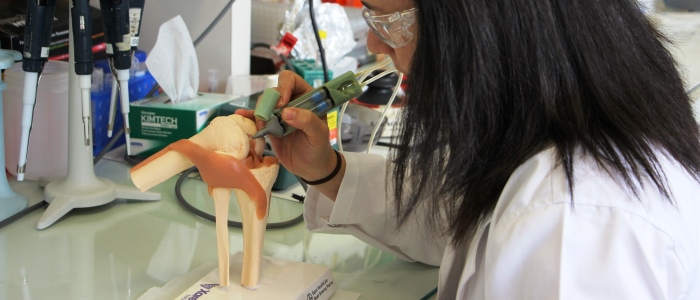Australian researchers from the ARC Center of Excellence for Electromaterials Science (ACES) and orthopedic surgeons at St Vincent's Hospital (Melbourne) have jointly announced the successful creation of a 3D printing pen that can produce human stem cells in freeform patterns, and with extremely high survival rates.
The device uses a hydrogel bio-ink to carry living human stem cells into the person’s body, and a light source to solidify the ink. Experiments thus far have recorded a survival rate for the stem cells of just slightly above 97%.
Its immediate purpose will be to allow surgeons to sculpt customized cartilage implants during surgery.

“The development of this type of technology is only possible with interactions between scientists and clinicians – clinicians to identify the problem and scientists to develop a solution,” said Professor Peter Choong, Director of Orthopaedics at St Vincent's Hospital Melbourne, who developed the concept with ACES Director Professor Gordon Wallace.
The idea of 3D bioprinters is exciting to many within the industry, as it is believed this technology will revolutionize tissue engineering (it allows for more precise layering of the cells).
The 3D printing pen allows the surgeon unprecedented control while treating defects. A good example is cartilage repair, where the exact geometry of an implant can’t be known before the surgery — this makes it very difficult to pre-prepare an artificial cartilage implant. The pen allows the surgeon to treat the defects by filling them with custom-made scaffolds right then and there on the surgery table.
The pen itself was designed with the practical constraints of surgery in mind — it was made using 3D printed, medical-grade plastic and titanium. It’s also small, lightweight, ergonomic, and completely sterilizable. There’s also a small, powered light source affixed to the device for the purpose of solidifying ink while it’s being dispensed.
“The biopen project highlights both the challenges and exciting opportunities in multidisciplinary research. When we get it right we can make extraordinary progress at a rapid rate,” Professor Wallace said.
To learn more, read the team’s published work, entitled Development of the Biopen: a handheld device for surgical printing of adipose stem cells at a chondral wound site.
Via the ARC Center of Excellence for Electromaterials Science
Advertisement
Learn more about Electronic Products Magazine





